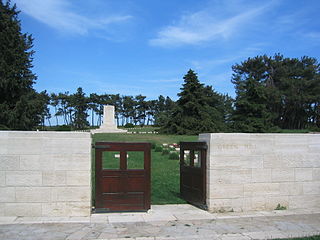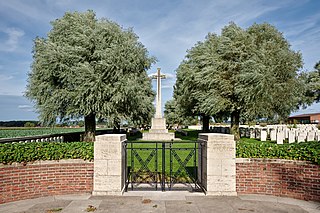
Lieutenant-General Sir Frederick Stanley Maude KCB CMG DSO was a British Army officer. He is known for his operations in the Mesopotamian campaign during the First World War and for conquering Baghdad in 1917.

The Battle of Hill 60 was the last major assault of the Gallipoli Campaign. It was launched on 21 August 1915 to coincide with the attack on Scimitar Hill made from the Suvla front by Major-General H. de B. De Lisle's British IX Corps, Frederick Stopford having been replaced in the few days previous. Hill 60 was a low knoll at the northern end of the Sari Bair range which dominated the Suvla landing. Capturing this hill along with Scimitar Hill would have allowed the Anzac and Suvla landings to be securely linked.

Tyne Cot Commonwealth War Graves Cemetery and Memorial to the Missing is a Commonwealth War Graves Commission (CWGC) burial ground for the dead of the First World War in the Ypres Salient on the Western Front. It is the largest cemetery for Commonwealth forces in the world, for any war. The cemetery and its surrounding memorial are located outside Passendale, near Zonnebeke in Belgium.

Duhallow ADSCemetery is a Commonwealth War Graves Commission burial ground for the dead of the First World War located near Ypres on the Western Front in Belgium.

Green Hill Cemetery is a Commonwealth War Graves Commission cemetery located near Suvla Bay, Gallipoli, Turkey.

The Nek Cemetery is a small Commonwealth War Graves Commission cemetery located near Suvla Bay on the Gallipoli Peninsula in Turkey.
Walker's Ridge Cemetery is a small Commonwealth War Graves Commission cemetery located near Suvla Bay in Turkey. It contains the remains of Allied soldiers killed during the Battle of Gallipoli.

Brandhoek New Military Cemetery is a Commonwealth War Graves Commission burial ground for the dead of the First World War located near Ypres in Belgium on the Western Front.

Buffs Road Cemetery is a Commonwealth War Graves Commission burial ground for the dead of the First World War located near Ypres in Belgium on the Western Front.

PerthCemetery is a Commonwealth War Graves Commission burial ground for the dead of the First World War located near Ypres (Ieper) in Belgium on the Western Front.

Woods Cemetery is a Commonwealth War Graves Commission burial ground for the dead of the First World War located near The Bluff south of Ypres (Ieper) in Belgium on the Western Front.
Shell Green Cemetery is a Commonwealth War Graves Commission Cemetery from World War I in the former Anzac sector of the Gallipoli Peninsula, Turkey for soldiers killed during the Gallipoli campaign. The eight-month campaign was fought by Commonwealth and French forces against Turkish forces in an attempt to force Turkey out of the war, to relieve the deadlock of the Western Front (France/Belgium) and to open a supply route to Russia through the Dardanelles and the Black Sea.
Hill 10 Cemetery is a Commonwealth War Graves Commission Cemetery in the former Suvla Bay sector of the Gallipoli Peninsula, Turkey. The battles at Gallipoli, some of whose participating soldiers are buried at this cemetery, was an eight-month campaign fought by Commonwealth and French forces against Turkish forces in an attempt to force Turkey out of the war, to relieve the deadlock of the Western Front (France/Belgium) and to open a supply route to Russia through the Dardanelles and the Black Sea.

Hill 60 Cemetery is a Commonwealth War Graves Commission cemetery dating from World War I at the Northern end of the former Anzac sector of the Gallipoli Peninsula, Turkey and the location of Hill 60 Memorial, one of four memorials on the peninsula which commemorate New Zealanders killed in the campaign but who have no known grave.

Courtney's and Steel's Post Cemetery is a Commonwealth War Graves Commission cemetery located near ANZAC Cove on the Gallipoli peninsula in Turkey. It contains the graves of some of the former British Empire troops who died during the Gallipoli Campaign.
Lala Baba Cemetery is a Commonwealth War Graves Commission cemetery on the Gallipoli Peninsula in Turkey. It contains the remains of some of the soldiers killed during World War I during the battles at Gallipoli. This was an eight-month campaign fought by Commonwealth and French forces against Ottoman Empire forces to try to force the Ottoman Empire out of the war which it was hoped would open a supply route from the Mediterranean to Russia through the Dardanelles and Istanbul and to relieve the deadlock on the Western Front.

The Bayeux War Cemetery is the largest Second World War cemetery of Commonwealth soldiers in France, located in Bayeux, Normandy. The cemetery contains 4,648 burials, mostly of the Invasion of Normandy. Opposite this cemetery stands the Bayeux Memorial which commemorates more than 1,800 casualties of the Commonwealth forces who died in Normandy and have no known grave.

The Arnhem Oosterbeek War Cemetery, more commonly known as the Airborne Cemetery, is a Commonwealth War Graves Commission cemetery in Oosterbeek, near Arnhem, the Netherlands. It was established in 1945 and is home to 1764 graves from the Second World War besides 4 later non-war graves and there are special memorials of two personnel buried elsewhere. Most of the men buried in the cemetery were Allied servicemen killed in the Battle of Arnhem, an Allied attempt to cross the Rhine in 1944, or in the liberation of the city the following year. Men killed in these battles are still discovered in the surrounding area even in the 21st century, and so the number of people interred in the cemetery continues to grow.
Captain Frank Reginald Beck, was a land agent to the British royal family. He helped to form a volunteer company comprising members of the royal staff. Under his leadership this unit fought in the Gallipoli campaign of 1915. Following the landings at Suvla Bay, as part of the August Offensive, Beck and many of his men went missing, presumed killed.














